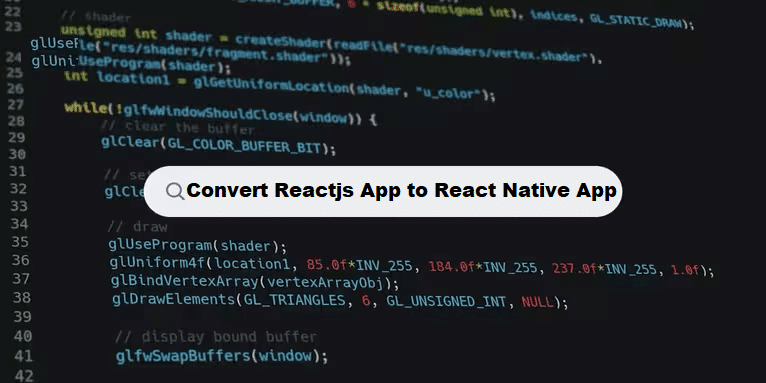Converting a React.js (web) application to React Native (mobile) isn’t a straightforward, one-click process. While React Native and React.js share many core principles (both use JavaScript and the same React syntax), the environment, APIs, and libraries for web vs. mobile are quite different. However, it’s possible to transition your application with some effort and planning.
Here’s a high-level approach to converting a React.js app to React Native:
1. Understand the Differences:
- Web vs Mobile: React.js is for web applications, while React Native is for mobile applications (iOS and Android).
- UI Components: In React.js, you use HTML tags like
<div>,<span>,<img>, etc. In React Native, there are equivalent components like<View>, `<Text>,<Image>, and - CSS vs Stylesheets: React.js relies on CSS for styling, while React Native uses a JavaScript-based styling system (using
StyleSheet.createor inline styles).
2. Rewriting the UI:
React Native does not support HTML or CSS directly, so you’ll need to translate your React.js components into React Native components. This means:
- Replace web-specific elements (
<div>,<span>, And<View>,<Text>, etc.). - Handle layout differently: React Native uses Flexbox for layout, similar to how CSS Flexbox works, but with some differences in how it behaves.
- Replace any web-specific libraries with mobile-friendly libraries or their React Native equivalents.
3. Navigation:
- React.js uses
react-routeror similar libraries for handling routes. - In React Native, you’ll need to use a navigation library like
react-navigationorreact-native-navigationto handle navigation between screens.
4. Handling APIs:
- API Calls: If your React.js app uses APIs (via
fetchoraxios), those will work the same way in React Native. Just ensure any web-specific logic is handled properly. - Mobile-specific APIs: React Native provides access to device features such as the camera, location, and push notifications, which you’ll need to implement using React Native libraries like
react-native-camera,react-native-location, etc.
5. Styling:
React
- In React.js, you might have CSS classes or external stylesheets, but in React Native, you’ll create styles using
StyleSheet.create(). - You can still make use of
Flexboxfor layout, but certain CSS properties (e.g.,position: absoluteorfloat) may not work the same way in React Native.
- React.js (CSS):
#css
.container {
display: flex;
justify-content: center;
align-items: center;
}
- React Native (JavaScript Style):
#css
const styles = StyleSheet.create({
container: {
flex: 1,
justifyContent: 'center',
alignItems: 'center',
},
});6. State Management:
State management (via useState, useReducer, or bookstore@react-native-async-storage/async-storage).
7. Dealing with Dependencies:
Some web-specific dependencies won’t work in React Native, such as those that rely on browser-specific features (e.g., localStorage, window object, etc.). You’ll need to replace these with React Native-compatible alternatives.
For example:
- Local Storage in React.js → AsyncStorage in React Now
- Fetch API: Works in React Native, but you might want to handle network requests differently for offline-first apps (with
react-query, `axioaxios, And
8. Testing:
Once you’ve rewritten the UI and handled the mobile-specific features, you’ll need to test your application on mobile devices or emulators. Mobile performance, touch events, and platform-specific behavior can differ significantly from web apps.
9. Build & Deployment:
After the conversion, React Native requires separate builds for iOS and Android:
- iOS: Using Xcode to build and deploy your app.
- Android: Using Android Studio to build and deploy your app.
Tools & Libraries:
- React Navigation: To ships
- Styled Components: You can use styled-components in React Native, similar to React.js.
- Expo: If you want a more “starter” environment, Expo can help by providing a set of tools for building and testing React Native apps quickly.
Note:
While you can’t directly “convert” a React.js app into a React Native app without rewriting the UI and adjusting the code to handle mobile specifics, the process involves transferring most of the business logic and structure while adapting to React Native’s platform-specific needs. In short:
- Web Components (
<div>,<span>) → React Native Components (<View>, `<Te<Text>) - CSS→ **ReactedReact Native Styles (JavaScript-based).
- Web Routing→ **Mobile ShipsMobile Navigation (React Navigation).
It’s a bit of work, but with careful planning, you can leverage much of your existing logic and state management.
Improving Data Management with Coding Filters!
For developers dealing with large datasets, coding filters provide an effective way to manage data more efficiently. By applying filters to sort, validate, or transform data, developers can ensure that only the necessary data is processed, making applications faster and easier to maintain.




